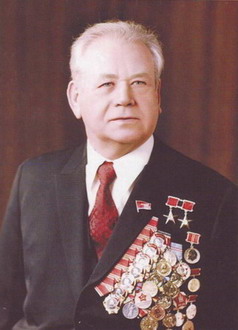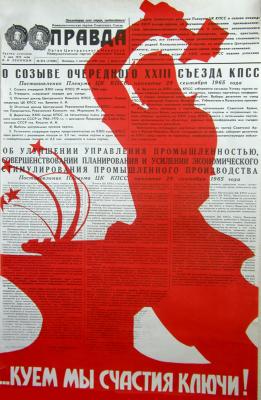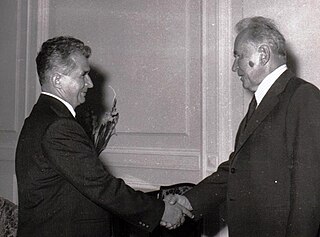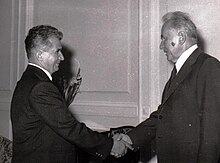
The history of the Soviet Union from 1982 through 1991 spans the period from the Soviet leader Leonid Brezhnev's death until the dissolution of the Soviet Union. Due to the years of Soviet military buildup at the expense of domestic development, and complex systemic problems in the command economy, Soviet output stagnated. Failed attempts at reform, a standstill economy, and the success of the proxies of the United States against the Soviet Union's forces in the war in Afghanistan led to a general feeling of discontent, especially in the Soviet-occupied Baltic countries and Eastern Europe.

Leonid Ilyich Brezhnev was a Soviet politician who served as General Secretary of the Communist Party of the Soviet Union from 1964 until his death in 1982, and Chairman of the Presidium of the Supreme Soviet from 1960 to 1964 and again from 1977 to 1982. His 18-year term as General Secretary was second only to Joseph Stalin's in duration. To this day, the value of Brezhnev's tenure as General Secretary remains debated by historians.

Andrei Pavlovich Kirilenko was a Soviet politician, and a member of the Secretariat of the Communist Party of the Soviet Union. He was one of the most loyal politicians to Leonid Brezhnev.

Nikolai Viktorovich Podgorny was a Soviet statesman who served as the Chairman of the Presidium of the Supreme Soviet, the head of state of the Soviet Union, from 1965 to 1977.

Alexei Nikolayevich Kosygin was a Soviet statesman during the Cold War. He served as the Premier of the Soviet Union from 1964 to 1980 and was one of the most influential Soviet policymakers in the mid-1960s along with General Secretary Leonid Brezhnev.

An index of articles related to the former nation known as the Soviet Union. It covers the Soviet revolutionary period until the dissolution of the Soviet Union. This list includes topics, events, persons and other items of national significance within the Soviet Union. It does not include places within the Soviet Union, unless the place is associated with an event of national significance. This index also does not contain items related to Soviet Military History.

Nikolai Aleksandrovich Tikhonov was a Soviet Russian-Ukrainian statesman during the Cold War. He served as Chairman of the Council of Ministers from 1980 to 1985, and as a First Deputy Chairman of the Council of Ministers, literally First Vice Premier, from 1976 to 1980. Tikhonov was responsible for the cultural and economic administration of the Soviet Union during the late era of stagnation. He was replaced as Chairman of the Council of Ministers in 1985 by Nikolai Ryzhkov. In the same year, he lost his seat in the Politburo; however, he retained his seat in the Central Committee until 1989.

The "Era of Stagnation" is a term coined by Mikhail Gorbachev in order to describe the negative way in which he viewed the economic, political, and social policies of the Soviet Union that began during the rule of Leonid Brezhnev (1964–1982) and continued under Yuri Andropov (1982–1984) and Konstantin Chernenko (1984–1985). It is sometimes called the "Brezhnevian Stagnation" in English.

The 1965 Soviet economic reform, sometimes called the Kosygin reform or Liberman reform, was a set of planned changes in the economy of the USSR. A centerpiece of these changes was the introduction of profitability and sales as the two key indicators of enterprise success. Some of an enterprise's profits would go to three funds, used to reward workers and expand operations; most would go to the central budget.

The Presidium of the 22nd Congress of the Communist Party of the Soviet Union (CPSU) was in session from 1961 to 1966. CPSU First Secretary Nikita Khrushchev chaired the Presidium from 1961 to 1964; Leonid Brezhnev succeeded him that year and chaired it until 1966. In contrast to full members, candidate members of the Presidium could not vote during Presidium sessions. It was normal that a full member of the Presidium had previously served as a candidate member, but this was not always the case. During the term 23 people held seats in the Presidium: 14 full members and 9 candidate members. One candidate member was promoted to full membership in the Presidium during the term. Not a single Presidium member died during this period while retaining office.
The energy policy of the Soviet Union was an important feature of the country's planned economy from the time of Lenin onward. The Soviet Union was virtually self-sufficient in energy; major development of the energy sector started with Stalin's autarky policy of the 1920s. During the country's 70 years of existence (1922–1991), it primarily secured economic growth based on large inputs of natural resources. But by the 1960s this method had become less efficient. In contrast to other nations who shared the same experience, technological innovation was not strong enough to replace the energy sector in importance.
The Eleventh Five-Year Plan, or the 11th Five-Year Plan, of the Union of Soviet Socialist Republics (USSR) was a set of goals designed to strengthen the country's economy between 1981 and 1985. The plan was presented by the Chairman of the Council of Ministers Nikolai Tikhonov at the 26th Congress of the Communist Party of the Soviet Union (CPSU).
The Tenth Five-Year Plan, or the 10th Five-Year Plan of the Union of Soviet Socialist Republics (USSR), was a set of goals designed to strengthen the country's economy between 1976 and 1980. The plan was presented by the Chairman of the Council of Ministers Alexei Kosygin at the 25th Congress of the Communist Party of the Soviet Union (CPSU). Officially the plan was normally referred to as "The Plan of Quality and Efficiency".
The Ninth Five-Year Plan of the Union of Soviet Socialist Republics (USSR) was a set of economic goals designed to strengthen the country's economy between 1971 and 1975. There was a marked slowdown in nearly all sectors of the Soviet economy by the time it ended. The plan was presented by the Chairman of the Council of Ministers Alexei Kosygin at the 24th Congress of the Communist Party of the Soviet Union (CPSU) in 1971.
The full understanding of the history of the late Soviet Union and of its successor, the Russian Federation, requires the assessment of the legacy of Leonid Brezhnev, the third General Secretary of the Central Committee of the Communist Party of the Soviet Union (CPSU) and twice Chairman of the Presidium of the Supreme Soviet. Leonid Brezhnev was the leader of the CPSU from 1964 until his death in 1982, whose eighteen-year tenure has been recognized for developing the most powerful military, and for social and economic stagnation in the late Soviet Union.

The 1973 Soviet economic reform was an economic reform initiated by Alexei Kosygin, the Chairman of the Council of Ministers. During Leonid Brezhnev's rule of the Union of Soviet Socialist Republics (USSR), the Soviet economy began to stagnate; this period is referred to by some historians as the Era of Stagnation. After the failed 1965 reform Kosygin initiated another reform in 1973 to enhance the powers and functions of the regional planners by establishing associations. The reform was never fully implemented, and members of the Soviet leadership complained that the reform had not even been fully implemented by the time of the 1979 reform.

The history of the Soviet Union from 1964 to 1982, referred to as the Brezhnev Era, covers the period of Leonid Brezhnev's rule of the Union of Soviet Socialist Republics (USSR). This period began with high economic growth and soaring prosperity, but gradually significant problems in social, political, and economic areas accumulated, so that the period is often described as the Era of Stagnation. In the 1970s, both sides took a stance of "detente". The goal of this strategy was to warm up relations, in the hope that the Soviet Union would pursue economic and democratic reforms. However, this did not come until Mikhail Gorbachev took office in 1985.

The history of Soviet Russia and the Soviet Union (USSR) reflects a period of change for both Russia and the world. Though the terms "Soviet Russia" and "Soviet Union" often are synonymous in everyday speech, when referring to the foundations of the Soviet Union, "Soviet Russia" often specifically refers to brief period between the October Revolution of 1917 and the creation of the Soviet Union in 1922.

The Council of Ministers of the Union of Soviet Socialist Republics, was the de jure government of the Union of Soviet Socialist Republics (USSR), comprising the main executive and administrative agency of the USSR from 1946 until 1991.

The economy of the Soviet Union was based on state ownership of the means of production, collective farming, and industrial manufacturing. An administrative-command system managed a distinctive form of central planning. The Soviet economy was characterized by state control of investment, prices, a dependence on natural resources, lack of consumer goods, little foreign trade, public ownership of industrial assets, macroeconomic stability, low unemployment and high job security.














